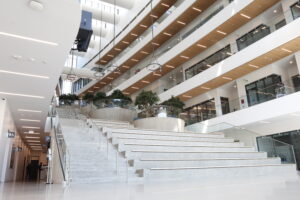The walkway along the West Mall Centre (WMC) parkade leading to the residence buildings is the main walkway students who live on campus use to get to class. It’s covered by a series of glass panels that were originally intended to protect you from the rain. . . except many of the glass panels cover only half of the walkway. Admittedly, this is an improvement that was made in 2014. When I began my degree in the fall of 2013, many panels were missing altogether.
I don’t think SFU realizes that its students live in the Vancouver area. I don’t know of anything more entrenched in the perception of Vancouver than rain, yet SFU still has trouble dealing with it.
An important part of any school in Vancouver is architecture that is capable of handling rainfall. In some ways, SFU is actually above-average in this field — architect Arthur Erickson’s original design of Burnaby campus was greatly favoured because it allowed students to get almost anywhere on campus while avoiding the rain. However, some issues such as water drainage have been left to fester, either because they were unaccounted for from the start or because the school has failed to maintain solutions.
Rainy days litter Burnaby campus with puddles: some small enough to miss, others big enough to rival the Academic Quadrangle (AQ) pond. From the bottom of the stairs to Convo Mall below the Rotunda to the north entrance of the AQ’s second floor, water regularly pools into cross-campus problems for students to deal with.
The inadequacy of that WMC walkway has been a problem for over four years, yet it still goes ignored. Since the beginning of 2013, a total of 12 large-scale construction projects at SFU based on campus renewal have been completed, with budgets totalling over $30,000,000. Yet, a handful of glass panels are still only half the appropriate size.
SFU consistently works on repairs and renovations, yet this issue continues to persist — and it doesn’t stop at puddles or students getting caught in drizzles. In 2013, The Tyee covered the damages and calls for repair that SFU’s aging campus had then brought upon itself, including “leaky pipes, mould infested classrooms and offices, crumbling stairs, and cracking foundations.”
Big, obvious problems linger because they’re too big to fix easily. Small, easy-to-fix problems linger because they’re small enough to ignore. But any student who has walked to class from residence knows how bothersome that walkway can become; finishing it would likely have just as much, if not more, of an impact on students as many of the large-scale construction projects currently underway. Either SFU is entirely unaware of this problem, or they are simply ignoring it. Neither are good excuses.
SFU’s image is said to be depressing. With the grey concrete and the overcast skies, it’s not hard to imagine why. When students have to constantly avoid puddles in many of the major walkways, the image of despair and disrepair only gets stronger. The persistence of these problems shows that SFU is either out of touch with what affects students on a day-to-day basis, or willfully ignoring an issue they know to be a problem. Either way, plenty of work needs to be done.














